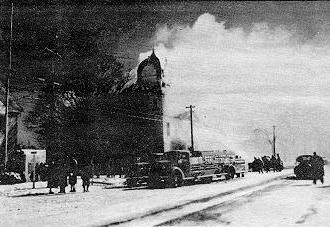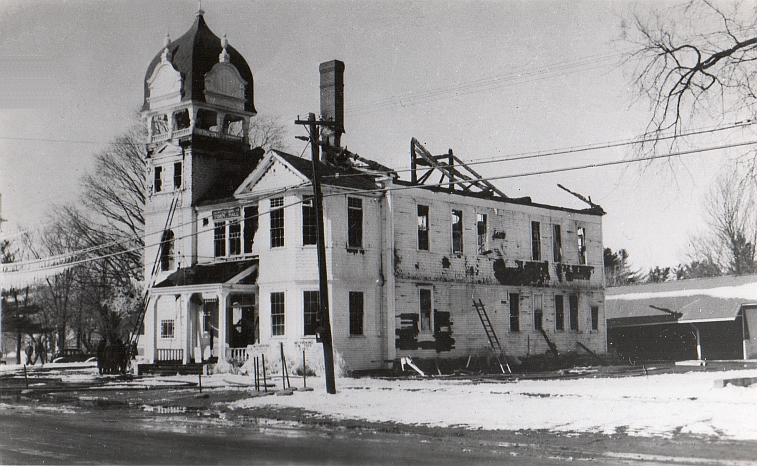Loss Set At $30,000 As Saturday Fire Guts Town Hall
Hampton Union, Thursday, March 24, 1949

A special town meeting has been called for Tuesday, April 7, to discuss the building of a new town hall in Hampton, as a result of an early morning fire Saturday which completely gutted the 152-year-old structure at an estimated loss of $30,000.
Only fire-blackened outer walls and the bell tower were left standing after a six-hour battle by firemen with the temperatures hovering about 10 degrees above zero. It was one of the coldest mornings of the winter with the wind whipping out of the northwest, coating the firemen with ice as thousands of gallons of water were poured into the burning building.
The fire was discovered shortly after 5:15 a.m. by Mrs. Katherine Janvrin Dickerman who was awakened in her home directly across the street from the town hall by the sound of an explosion. Looking out the window Mrs. Dickerman noticed that the front doors of the town hall had been blown open and that flames were pouring out the windows on the west side of the building.
The Hampton Beach Fire Department was notified at 5:21 and responded with four pieces of apparatus. Although the fire department sub station is located next door to the Town Hall, the permanent fireman on duty there was not awakened by the explosion.
When the firemen arrived on the scene at 5:30, the wooden structure was a seething mass of flames, but the prompt work of the fire department helped to save nearby property. Fire Chief George H. Lamott theorized that the fire started from the over-heated hot air furnace and that it had been smoldering in the wall and between the floors for five-six hours before the hot air explosion broke open the windows and doors fanning the flames throughout the entire structure.
The vital town records which were kept in the steel and cement reinforced vault built approximately 15 years come through the fire undamaged and much of the equipment and supplies in the front office was found undamaged when town officials began to clear the ruins Monday.
At a closed meeting of the Selectmen and other Town officials Saturday afternoon it was decided to erect a temporary building 20 by 20 on town land adjacent to where the Town Hall was located and work on the project was begun Monday morning. Meanwhile temporary offices for Town Clerk William Brown were set up in the sub-fire station.
Clearing of the wreckage was begun Monday morning with town officers sorting out rescued records. The town's $80,000 clock suffered some smoke and water damage but most of the office equipment was saved.
Selectman Harry D. Munsey and the four-man town work crew escaped injury when they left the building for lunch. While they were away the chimney toppled to the ground, burying the area where they had been at work clearing debris.
Tuesday afternoon the Savin Construction company succeeded in getting the bell down from the sagging belfry by knocking off the cupola, which had been weakened by the fire. Contrary to previous reports the bell was found to have been cast in 1861 in Troy, New York and not in England 200 years ago.
The loss of Town Hall has been set at $30,000 by Selectmen and fire insurance officials, although the building is carried on the town inventory at $10,000. Selectmen (sic) Harry D. Munsey stated that insurance of $10,000 was carried on the building and that it had been adjudged a total loss.
The building was built in 1797 and was used as a church by the Congregationalists and also by the Presbyterians. The first minister of the church was Rev. Jesse Appleton, later president of Bowdoin collage and whose daughter married Franklin Pierce, New Hampshire's only president.
In 1843 the present Congregational church said to be the oldest congregational church in the state, was built directly opposite from Town Hall.
Using the old Congregational church as a town hall, the town kept it in its original form until 1860 when the steeple was taken down and the belfry replaced it.
During the years, an addition was built on the front of the 45' by 60' hall and the downstairs portion was modified to accommodate the town offices and municipal room.

